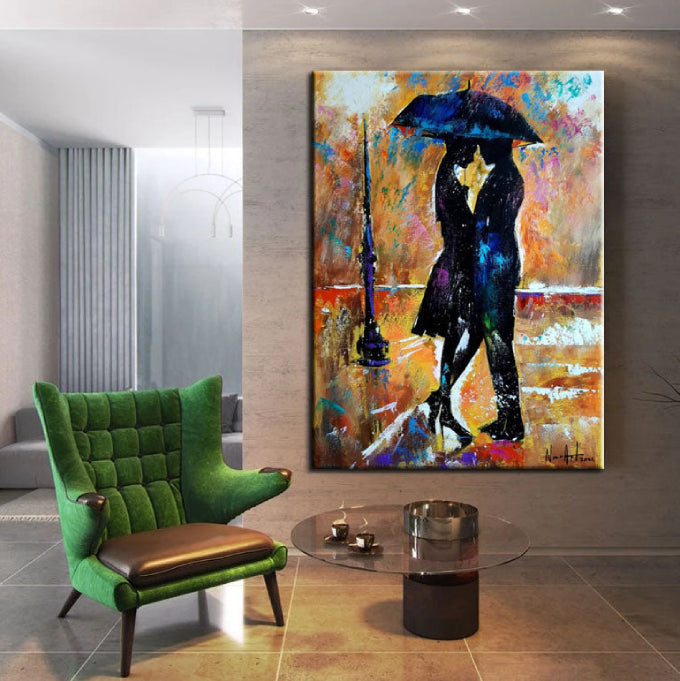5 Health Benefits of Viewing Art in Your Home
From oil on canvas in stately mansions to abstract art in chic apartments, paintings have long adorned our living spaces. When decorating our homes, our designs and color schemes show our style and give us pleasure.
Choosing paintings is no different. Whether realism, impressionism, or abstract art is your passion, did you know that looking at art in your home is good for your health, too?
Everyone knows that their mindset and mood play a pivotal role in their mental health. Our mental health, in turn, can reflect the state and health of the rest of our being. Here’s how art can help in this regard and turn this story around.
Your walls are your canvas for self-expression

Having art in your home isn’t just a matter of artistic taste. The paintings you choose also reflect your personality, culture, life experiences, and interests. Just as artist communicates through their art, we tell our stories and convey our emotions through the artwork we hang on our walls.
Art starts conversations with friends and family, too – people love to share their thoughts. So, whether you make a bold statement or prefer subtle messages and tones, the art in your home is a way to express your identity.
This act of personalization is crucial for nurturing a sense of self and belonging. In a world that often feels chaotic and impersonal, coming home to a space that speaks to your soul can be a profound source of comfort and inner peace.
Such visuals can act as visual escape hatches, offering moments of contemplation and tranquility amidst the hustle and bustle of everyday life. They serve as reminders of beauty and creativity, fostering an environment that can reduce stress, inspire thoughts, and encourage positivity.
Art elevates mood and encourages mindfulness
When we look at beautiful abstract paintings, the blood flow to our brain increases just like it does when we look at someone we love.
According to research by University College London: “When you look at art – whether it is a landscape, a still life, an abstract or a portrait – there is strong activity in that part of the brain related to pleasure,” says Neurobiologist Professor Semir Zeki, who led the study.
If you enjoy wandering around art galleries, you’ll be familiar with losing track of time as you contemplate each painting. You can create similar opportunities for mindfulness and connection with visual art in your home.
Art has this unique ability to pause the noise of the external world, drawing our focus to the present moment. As we engage with a piece of art, we're prompted to slow down, observe, and reflect. This process of closely examining the colors, textures, and emotions conveyed through art can be a meditative experience, encouraging a state of mindfulness.
In this hectic world, the ability to slow us down and make us observe is, on its own, invaluable. By fostering a mindful environment, art helps us cultivate a deeper awareness of our thoughts and feelings, enhancing our overall sense of well-being.
Artworks that resonate with us personally can act as a source of joy and inspiration, lifting our spirits and sparking creativity.
Art stirs positive emotions that reduce stress

Studies have shown that exposure to art can lower cortisol levels, the body's primary stress hormone, thereby diminishing the physical and psychological effects of stress.
This is why art therapy is used as a natural way to treat anxiety and depression, and this hands-on experience also reduces the stress hormone cortisol to healthier levels. But if creating art isn’t your thing, the same benefits can be enjoyed simply by looking at art. Visual art also has an anti-inflammatory effect. A study by UC Berkeley found that art evokes positive emotions, which reduce inflammatory proteins in the body.
The act of engaging with art — whether it's admiring a painting, losing oneself in a photograph, or being moved by a sculpture — activates parts of the brain associated with pleasure and reward, helping to uplift our mood and combat feelings of anxiety and depression.
In essence, art offers an emotional escape, allowing us to momentarily transcend our immediate concerns and immerse ourselves in a realm of creativity and wonder.
Looking at paintings boosts brainpower
Science now backs up what art enthusiasts have long felt about art. Looking at people’s reactions to art from a neurological perspective, studies in the field of neuroaesthetics confirm that art is good for your brain. Paintings can stimulate critical thinking, pattern matching, decision-making, idea generation, and emotional connection as we search for meaning.
Looking at art isn't just a feast for the eyes; it's a rigorous workout for the brain. When we engage with art, our brains are set into motion, decoding complex visual signals, interpreting meanings, and connecting emotions to what we see. This process enhances cognitive functions, challenging our perception, critical thinking, and problem-solving skills.
When we contemplate a piece of art, we're not just passively observing; we're actively constructing meaning, drawing on personal experiences, cultural contexts, and emotional insights.
Art can help you heal emotionally

Viewing art also helps us explore our emotions and experiences and heal, says psychologist and poet Joan Cusack Handler. “While active involvement with making art involves creative expression of what one feels — consciously and unconsciously, so too participation in another’s experience helps us to access those feelings in ourselves.”
Also, did you know that art can speed up post-operation recovery? A study published in the Journal for Organizational Psychology found that the mood uplift from looking at Abstract Romanticism paintings reduced the length of stay in the hospital.
Moreover, art possesses a profound capacity to facilitate emotional healing, serving as both a mirror to our innermost feelings and a window to alternative perspectives. Engaging with art allows individuals to process emotions that may be difficult to articulate verbally, offering a unique form of expression that transcends words.
Lastly, art can act as a silent companion that validates our experiences, making us feel seen and understood. Through this emotional resonance, art has the power to comfort, inspire, and instigate healing.
The full list of benefits of having art in your home is just too long for any post
So, when we surround ourselves with beautiful paintings, we’re not only creating a stylish home and pleasing environment for living and working, but we enjoy health benefits, too!
For immediate impact in your living room, dining room, bedroom, kitchen, or hall, we have curated an eclectic selection of handmade oil and acrylic paintings on canvas, framed for a professional finish.
Create your own style and decor with original Art by Maudsch. Enjoy!
